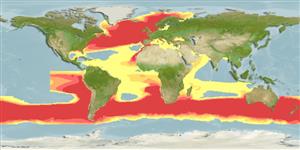分類 / Names
共通名の | 類義語 | Catalog of Fishes(部類, 種) | ITIS | CoL | WoRMS | Cloffa
板鰓亜鋼(サメとエイ類) (sharks and rays) >
Lamniformes (Mackerel sharks) >
Lamnidae (Mackerel sharks or white shark)
Etymology: Lamna: From the Greek lamia, a large and voracious shark, originally from Lamia in Greek mythology, daughter of King Belos, who revenged the murder of her children by killing the children of others, and who behaved so cruelly that her face turned into a nightmarish mask. (See ETYFish); nasus: Latin for nose, referring to moderately long conical snout. (See ETYFish).
More on author: Bonnaterre.
Environment: milieu / climate zone / depth range / distribution range
生態学
海; 海洋回遊性 (Ref. 51243); 深さの範囲 0 - 1360 m (Ref. 114967), usually 0 - 300 m (Ref. 119696). Boreal; -1°C - 23°C (Ref. 98315); 76°N - 59°S, 180°W - 180°E (Ref. 247)
Circumglobal, amphitemperature with centers of distribution in the North Atlantic and temperate water of the southern hemisphere; not in equatorial seas.
Length at first maturity / サイズ / 重さ / 年齢
Maturity: Lm 186.5, range 170 - 219 cm
Max length : 350 cm TL オス/雌雄の選別がない; (Ref. 4645); common length : 244 cm TL オス/雌雄の選別がない; (Ref. 5951); 最大公表体重: 230.0 kg (Ref. 40637); 最大記録サイズ: 65 年 (Ref. 119696)
背面の脊椎 (合計) : 0; 肛門の骨: 0. A stout, spindle-shaped shark with large black eyes, a sharp, conical snout, long gill slits, and small, smooth-edged, narrow teeth with side cusps (Ref. 5578, 88171). Strong keels on the caudal peduncle, short secondary keels on the caudal base, and a crescentic caudal fin; the insertion of the small second dorsal fin is above the insertion of the anal fin (Ref. 88171). Dark grey dorsally, white ventrally, without blotches (Ref. 6581, 43278); rear tip of 1st dorsal abruptly white (Ref. 5578).
Occurs inshore to offshore fishing banks and occasionally to open ocean areas. It is migratory, moves generally along the continental shelves (inshore to surface during simmer) and winters offshore in deeper water (Ref. 58085). Most abundant on continental offshore fishing banks but also found far from land in ocean basins and occasionally close inshore (Ref. 247). Extreme depth reported to 1,360 meters. Age attained in North Atlantic at least 26 years and in the Southern Hemisphere probably 65 years (Ref. 119696). Specimens tagged off southern England were recaptured in northern Norway (having travelled 2,370 km), Denmark and Spain (Ref. 88752, 88753). The northwest Atlantic stock migrates from Newfoundland, Canada in the winter to Massachusetts in the summer (Ref. 43278, 88754). Trans-Atlantic migrations have also been recorded. One of the most cold-tolerant sharks; in the northwest Atlantic mostly found from 5-10°C (Ref. 88755); with extremes of -1°C and 23°C (Ref. 119696). Known to temporarily tolerate salinities as low as 10 to follow its prey (Ref. 88740). Found singly and in schools and feeding aggregations (Ref. 247). Feeds on small and medium-sized pelagic schooling species, other sharks, squid (Ref. 5578) and demersal fishes (cod, white hake, red hake, haddock and cusk (Ref. 5951, 43278)). Ovoviviparous species (Ref. 43278, 50449). Females grow larger than males (Ref. 88756). Parasites include Phyllobothrium dagnallium (found in stomach, intestine and spiral valve) and Dinobothrium sp. (Ref. 5951). Regarded as potentially dangerous to people because of its size and activity but has never or very seldom been indicted in an attack on people or boats (Ref. 247). Considered by some as a sport fish (Ref. 84357). The flesh of the porbeagle is of good quality and texture and is said to taste like swordfish (Ref. 84357). Utilized fresh, dried or salted and frozen for human consumption; for oil and fishmeal; fins for shark-fin soup (Ref. 247). May be pan-fried and broiled (Ref. 9988). Catch records and studies in the northeast Atlantic show segregation by sex and size (Ref. 56108, 88756, 88757).
Distinct pairing with embrace (Ref. 205). Ovoviviparous (aplacental viviparity), with uterine cannibalism (embryos feeding on other ova produced by the mother (oophagy) after the yolk sac is absorbed) (Ref. 43278, 50449). With 1-5 (usually 4) pups in a litter (Ref. 6871, 43278). Reproduction probably yearly (Ref. 45602). In the northeast Atlantic, breeding grounds are off the coast of Europe and the British Isles. Embryos found in mature females throughout the year except from July to September. Mating occurs in late summer, pups are born in the spring of the following year (Ref. 43278). Gestation may last 8-9 months. Size at birth 60-80 cm TL (Ref. 6871, 43278).
Compagno, L.J.V., 1984. FAO Species Catalogue. Vol. 4. Sharks of the world. An annotated and illustrated catalogue of shark species known to date. Part 1 - Hexanchiformes to Lamniformes. FAO Fish. Synop. 125(4/1):1-249. Rome, FAO. (Ref. 247)
人間に対する脅威
Traumatogenic (Ref. 4690)
Human uses
水産業: 商業; ゲームフィッシュ: はい
用具
特記事項
XMLをダウンロードして下さい
インターネットの情報源
Estimates based on models
Preferred temperature (Ref.
123201): 3.1 - 16.3, mean 7.8 °C (based on 1486 cells).
Phylogenetic diversity index (Ref.
82804): PD
50 = 0.7813 [Uniqueness, from 0.5 = low to 2.0 = high].
Bayesian length-weight: a=0.01047 (0.00604 - 0.01816), b=3.03 (2.87 - 3.19), in cm total length, based on LWR estimates for this species & (Sub)family-body (Ref.
93245).
栄養段階 (Ref.
69278): 4.6 ±0.0 se; based on diet studies.
Generation time: 9.5 ( na - na) years. Estimated as median ln(3)/K based on 1
growth studies.
回復力 (Ref.
120179): 非常に低い, 14年以上の倍増期間の最小個体群 (K=0.12; tm=5; tmax=30; Fec=1-5).
Prior r = 0.05, 95% CL = 0.03 - 0.07, Based on 3 full stock assessments.
Fishing Vulnerability (Ref.
59153): High to very high vulnerability (74 of 100).
Climate Vulnerability (Ref.
125649): High vulnerability (62 of 100).
Nutrients (Ref.
124155): Calcium = 2.77 [0.73, 15.82] mg/100g; Iron = 0.301 [0.075, 1.026] mg/100g; Protein = 19.2 [16.9, 21.6] %; Omega3 = 0.387 [0.159, 0.924] g/100g; Selenium = 16 [5, 47] μg/100g; VitaminA = 6.86 [1.47, 34.61] μg/100g; Zinc = 0.202 [0.100, 0.381] mg/100g (wet weight); based on
nutrient studies.
